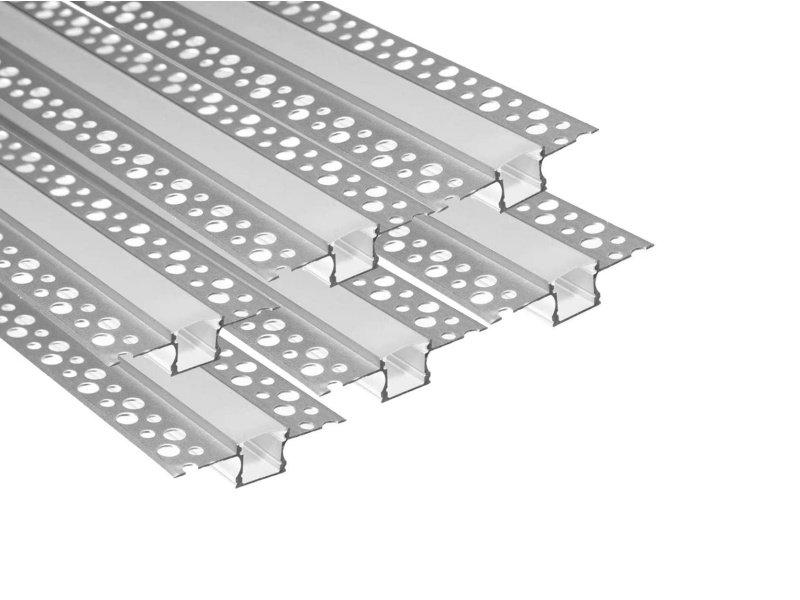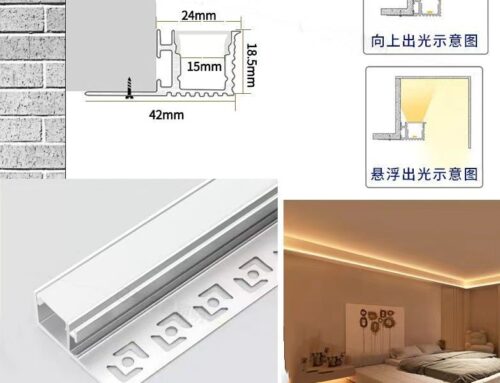LED aluminum profiles are essential components for modern lighting solutions, providing both function and style. These profiles house LED strips, offering protection and enhancing light diffusion. Crafted from high-quality aluminum, they ensure durability and excellent heat dissipation, which is crucial for the longevity of the LEDs. These profiles come in various shapes and sizes, each designed to suit different lighting needs and applications, from residential to commercial settings.
Aluminum LED Channel and Diffuser
An aluminum LED channel paired with a diffuser transforms your LED strip lighting into a seamless and elegant light source. The aluminum channel acts as a robust housing that secures the LED strips and helps with heat management. The diffuser, usually made of frosted or opal plastic, softens the harshness of direct LED light. This combination not only protects the LEDs from dust and physical damage but also provides a more uniform light output, reducing glare and creating a smoother light effect.
45 Degree Aluminum LED Channel
The 45-degree aluminum LED channel is designed for specific lighting scenarios where light needs to be directed at an angle. Perfect for under-cabinet lighting, shelving, or architectural accents, this profile directs light downwards at a 45-degree angle, enhancing visibility and adding a touch of sophistication to your space. The angled design also helps in reducing direct glare, making it an excellent choice for task lighting.
Aluminum Channel for LED Strips
Aluminum channels for LED strips are versatile components that come in various designs to meet different installation needs. They provide a secure fit for LED strips, preventing them from sagging or being exposed to damage. By enclosing the LED strips, these channels also help in dissipating heat effectively, which is vital for maintaining the performance and lifespan of the LEDs. Whether you’re installing them in a residential, retail, or office setting, these channels offer both aesthetic and functional benefits.
LED Channel Track
LED channel tracks are the backbone of any professional LED strip installation. These tracks ensure that the LED strips are mounted securely and align perfectly with the desired layout. Available in different lengths and widths, they can be customized to fit any project, making installation straightforward and efficient. The track system also allows for easy maintenance and replacement of LED strips, ensuring your lighting setup remains optimal over time.
LED Light Channel Diffuser
A diffuser in an LED light channel is a crucial component for achieving a pleasant and consistent light output. The diffuser spreads the light emitted by the LED strips, eliminating harsh shadows and creating a smooth, even light distribution. This is particularly important in settings where visual comfort is a priority, such as in living spaces, offices, or retail environments. Diffusers are available in various levels of transparency, allowing you to choose the right one for your desired light effect.
LED Strip Light Channel
LED strip light channels are designed to hold and protect LED strips, enhancing their functionality and appearance. These channels come in different profiles, such as recessed, surface-mounted, or corner-mounted, to suit various installation requirements. They not only provide a clean, finished look to the LED strips but also improve the overall light output by acting as a heat sink. This ensures that the LEDs operate at an optimal temperature, reducing the risk of overheating and extending their lifespan.
Black LED Channel
Black LED channels are a stylish choice for modern lighting designs. They offer a sleek, contemporary look that blends seamlessly with darker surfaces and decors. Besides their aesthetic appeal, black channels also provide the same functional benefits as other aluminum profiles, including protection, heat dissipation, and light diffusion. They are particularly popular in settings where the lighting fixtures are meant to be a design feature, adding a touch of elegance to the overall space.
Aluminum LED Profile
Aluminum LED profiles are highly versatile and robust, making them suitable for a wide range of lighting applications. These profiles can be surface-mounted, recessed, or suspended, depending on the installation needs. They provide excellent protection for LED strips and help in managing heat, which is crucial for maintaining the efficiency and longevity of the LEDs. With a variety of shapes and sizes available, these profiles can be used in both decorative and functional lighting projects.
What Size Are LED Profiles?
LED profiles come in various sizes to fit different types of LED strips and installation requirements. Common sizes include slim profiles for discreet installations, standard profiles for general use, and larger profiles for high-output LED strips. The size of the profile you need depends on the width of your LED strip and the specific application. Slim profiles are ideal for accent lighting, while larger profiles are better suited for main lighting sources or areas requiring higher light output.
What is Aluminum Profile Standard?
Aluminum profile standards refer to the industry guidelines that ensure compatibility and quality across different manufacturers and applications. These standards dictate the dimensions, tolerances, and material specifications of the profiles, ensuring they fit properly with LED strips and other components. Adhering to these standards ensures that the profiles provide reliable performance, ease of installation, and longevity, regardless of the specific application.
Can You Cut LED Profile?
Yes, LED profiles can be cut to fit specific installation needs. This allows for customization and precision in your lighting projects. Whether you need a profile to fit into a tight space or to match the exact length of an LED strip, cutting the profile ensures a perfect fit. It’s important to use the right tools and techniques to achieve a clean cut, which will help maintain the profile’s structural integrity and aesthetic appeal.
How to Cut an Aluminum LED Channel?
To cut an aluminum LED channel, you will need a fine-toothed hacksaw or a miter saw equipped with a metal-cutting blade. Begin by measuring and marking the desired length on the channel. Secure the channel in a vise or on a stable work surface to prevent movement while cutting. Use steady, even strokes if using a hacksaw, or let the miter saw do the work if using power tools, to ensure a straight, clean cut. After cutting, smooth any rough edges with a file or sandpaper.
How to Cut a LED Profile Corner?
Cutting a LED profile corner requires precision to ensure a seamless fit. Using a miter saw is the most effective method. Measure and mark the angle required for the corner joint, typically 45 degrees for standard corners. Secure the profile in the saw’s vise, align the blade with the marked line, and make the cut. Repeat this process for the connecting profile piece. Fit the two pieces together to check for accuracy and make any necessary adjustments. This method ensures clean, professional-looking corner joints in your LED lighting installation.












Leave A Comment